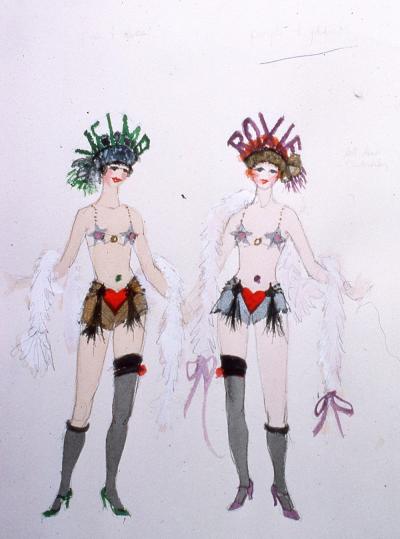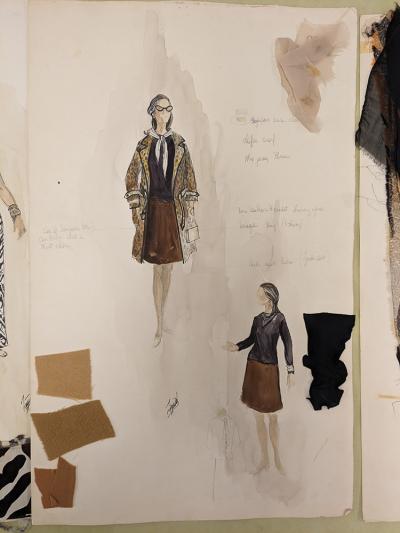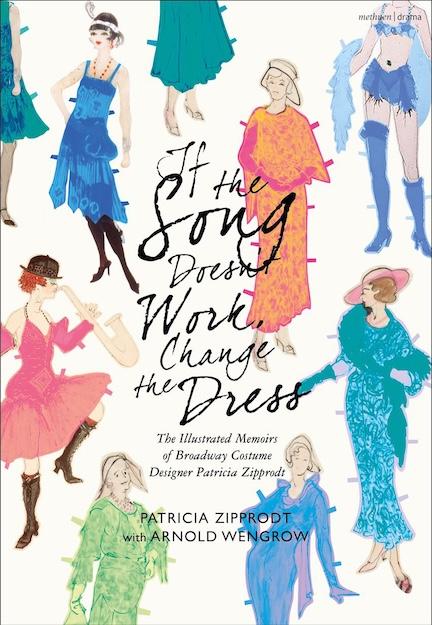Costume designer Patricia Zipprodt (1925-1999) is an especially important figure in the development and practice of the costume design profession in the twentieth century. A monograph about her life and career has been sadly missing. The theatre community (and attendees at any of the performing arts) are in Arnold Wengrow’s debt. He has corrected this absence with the publication of If the Song Doesn't Work, Change the Dress: The Illustrated Memoirs of Broadway Costume Designer Patricia Zipprodt, published in 2025 by Methuen|Drama, an imprint of Bloomsbury Publishing. The book consists mainly of Zipprodt's memoirs with copious footnotes that add context and an epilogue that completes the narration Zipprodt was not able to provide before her death.
Filled with full-color images of her original designs as well as production photographs, Wengrow's work takes readers from one original Broadway play to another: A Visit to a Small Planet, A Streetcar Named Desire, The Rope Dancers, Plaza Suite and others; and from one original Broadway musical to others: Cabaret, Fiddler on the Roof, Chicago, and Pippin. Being part of the development of these quintessential American plays and musicals meant she was part of their conception, collaborating with Jerome Robbins, Hal Prince, José Quintero, and Bob Fosse, among many others. She also worked with some of the great scenic and lighting designers of the same era: Tony Walton, Jo Mielziner, and Boris Aronson. In addition, Zipprodt’s apprenticeship with legendary designer Irene Sharaff gave her many of the necessary skills and tools for working in those environments – on top of her own extraordinary talent for realizing character through costume and her formidable personality. Not limited to theatre (or musicals) she also designed for dance productions and major motion pictures.

Readers will appreciate learning about Patricia Zipprodt's roots in Chicago during the Great Depression and her path to becoming a successful designer. They will also value her frankness about her struggles with drugs and alcohol and how she overcame them. Finally, a number of readers will be even more interested in how she balanced her personal and creative lives in spite of enduring the relentless time pressure of launching an original Broadway production in the 1970s and 1980s when technology (even access to original research materials) was less available than it is today.
Zipprodt was known for doing extensive research for productions, via print materials and through interviews, as well as visits to museums and archives. Over the years she taught her many assistants (her legacy is amazing) about mining sources of information for useful details that could be easily overlooked. Her designs for Fiddler on the Roof are so evocative of time and place that they are often used as primary research for subsequent productions (some discerning readers might call this appropriating).

Memoirs often suffer from being incomplete and too dependent on memories that have shifted over time. Arnold Wengrow adeptly solves this problem by providing extensive footnotes that give much needed background. The footnotes do not interrupt the narrative because they are available when names and places are elusive; Zipprodt had no need to record complete details when she was compiling her memories. Memoirists can also be selective about what they record and what gets omitted. In her memoir Zipprodt often regales the reader with gossipy details about difficult fittings, unsavory offices, and uncooperative performers. While Zipprodt's description of her experience in Hollywood (and with inattentive agents) is remarkable (and chilling), it nevertheless resulted in her involvement with The Graduate. Directed by Mike Nichols, the film appears on many lists as one of the top movies of the twentieth century.
Patricia Zipprodt did not include in her memoir what some might regard as her seminal designs. For example, Sleeping Beauty (1991), which remains in the repertory of New York City Ballet, is omitted. It is a delightful, sumptuous production. Her collaboration with the great costume maker, Barbara Matera, occurred during the height of both their creative powers. The chronology is useful but it is not as complete as It might be, especially related to dance. And, it might be even more useful if it contained information about her collaborators, many of whom are not included in the text.
The New York Public Library for the Performing Arts is the repository for Zipprodt’s archive. It also contains extensive collections of major theatre photographers, including Martha Swope, Herbert Migdoll, and Joan Marcus, who took photographs of many of the productions Zipprodt designed. Scholars and other interested folks can see them in person at Lincoln Center.
Arnold Wengrow was the perfect choice to complete Zipprodt’s book. He spent the majority of his career at the University of North Carolina at Asheville, where he served as artistic director of theatre from its founding in 1970 until his retirement in 1998. As a director and design historian, his own experience in the theatre makes him uniquely qualified to write about other theatrical designers and their relationships with directors (and performers). He is the author of Robert Redington Sharpe: The Life of a Theatre Designer; Observe and Show: The Theatre Art of Michael Annals; and The Designs of Santo Loquasto.
William (Bill) Woodman is appropriately acknowledged in the book. Readers also owe him thanks for getting Patricia Zipprodt to record her memories. He was persuasive and is owed much credit for convincing her to document her life and career – in her own feisty and spirited voice – which echoes loud and strong in Wengrow's text.

It is easy – a no-brainer, really – to recommend this book to anyone who loves the performing arts. It is also relevant for anyone pondering a career in theatre and film! Savor her memories, mainly reprised in her own voice – and keep the legacy of this remarkable and talented woman as vital as she was in person.
Bobbi Owen
Michael R. McVaugh Distinguished Professor Emerita
University of North Carolina at Chapel Hill
May 5, 2025
If the Song Doesn't Work, Change the Dress: The Illustrated Memoirs of Broadway Costume Designer Patricia Zipprodt
Images courtesy of Billy Rose Theatre Division, The New York Public Library for the Performing Arts; ©Estate of Patricia Zipprodt
- By Patricia Zipprodt and Arnold Wengrow
- Publisher : Methuen Drama (February 6, 2025)
- Language : English
- Hardcover : 216 pages
- ISBN-10 : 135043065X
- ISBN-13 : 978-1350430655
- Item Weight : 1.51 pounds
- Dimensions : 6.95 x 0.75 x 9.8 inches
- Available on Amazon